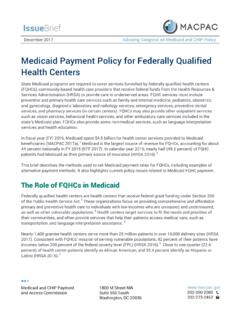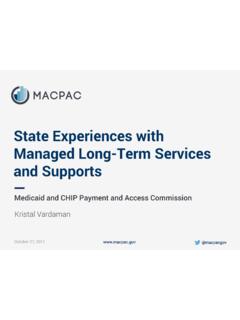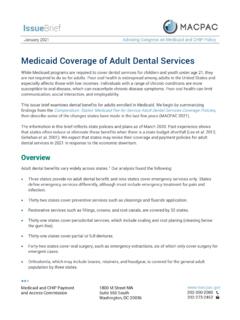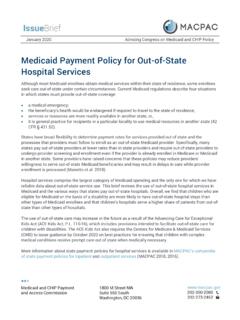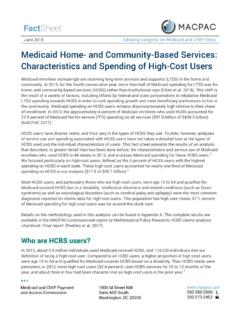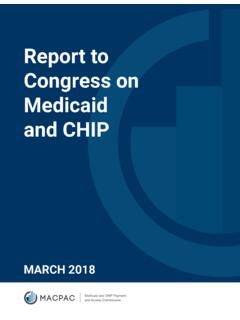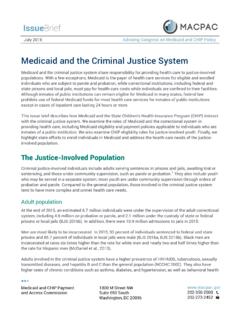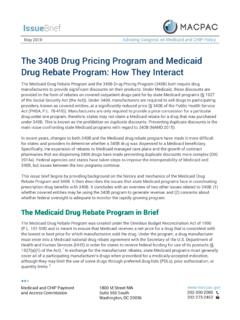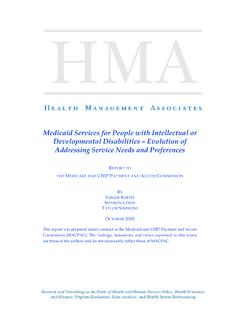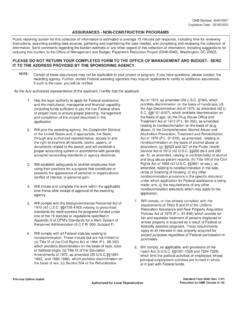Transcription of Medicaid in Schools - MACPAC
1 April 2018 Advising Congress on Medicaid and CHIP Policy Medicaid in Schools Medicaid pays for health and related services provided in Schools when covered services are provided to Medicaid -enrolled children and adolescents, or when services are provided to a child through his or her individualized education plan (IEP) under the Individuals with Disabilities Education Act (IDEA, 101- 476). As part of the activities necessary to administer the Medicaid state plan, states may also provide Medicaid payments to Schools for Medicaid outreach and enrollment activities, as well as other eligible, school -based administrative activities.
2 Medicaid spending on school -based services and Medicaid -related administrative services was estimated to be $ billion in fiscal year (FY) 2016 (Appendix). This issue brief describes coverage of school -based services under Medicaid and how states pay for them. school -Based Services Schools are an important setting for providing health services to children with Medicaid coverage for two key reasons. First, Schools are a convenient point of access for health and related services because children are in school for many hours a day, for approximately half the days of the year (CMS 1997). Second, IDEA requires public Schools to provide all children with disabilities (generally between the ages of 3 to 21) with a free and appropriate public education.
3 1 This includes both education and related services, such as speech or physical therapy, which support a child's ability to learn. Most of the services provided to children in Schools are covered by Medicaid , either under state plan authority or under the Early and Periodic Screening, Diagnostic, and Treatment (EPSDT) benefit. 2 Schools may also receive Medicaid payment for related administrative activities. To receive Medicaid payment for health and related services, Schools , providers in Schools , or school - based health centers must meet federal and state requirements for Medicaid providers (42 CFR , CMS 1997).
4 school -based services for children with disabilities Since 1988, states have been able to draw down federal funds under Medicaid to pay for school -based health and related services required by IDEA, when provided to Medicaid -eligible children with disabilities. 3. Under IDEA, children with disabilities are eligible to receive educational and related services that will help them achieve their educational goals, as documented in each child's IEP, or for infants and toddlers (children under age three), the individualized family service plan (IFSP). These services must be provided in the school , although children may also receive similar services outside the school setting.
5 The IEP is a written plan developed by the school 's IEP team that describes a plan for the child's education. 4 Every IEP is tailored to a child's specific circumstances and needs. Required components of an IEP include: 2. an assessment of a child's academic and functional performance level;. annual educational goals;. the educational and related services that a school will provide to help a child reach his or her goals;. any program modifications or accommodations for school personnel to help support the child participate or make progress in their education; and a plan to measure a child's progress toward annual goals (34 CFR ).
6 The IFSP is similar to an IEP but focused on the needs of infants and toddlers. An IFSP team establishes the plan to provide early intervention services to meet the physical, cognitive, communication, social and emotional, and adaptive developmental needs of an infant or toddler with a disability (34 CFR ). Examples of early intervention services include audiology, occupational therapy, physical therapy, and vision services (34 CFR ). State Medicaid programs may cover services included in a child's IEP or IFSP as long as (1) the services are listed in Section 1905(a) of the Social Security Act and are medically necessary; (2) all federal and state regulations are followed, including those specifying provider qualifications; and (3) the services are included in the state plan or available under EPSDT.
7 Covered services may include, but are not limited to, physical therapy, occupational therapy, speech pathology or therapy services, psychological counseling, nursing, and eligible transportation services. Coverage of school -based services, including categories of service ( , speech, language and audiology services, or behavioral health services) and specific types of services ( , screening services or individual treatment) varies by state (Baller and Barry 2016). For example, most states and the District of Columbia include occupational or physical therapy in their coverage of school -based services.
8 However, while most states cover evaluation and individual treatment services, fewer cover screening or group treatment (Baller and Barry 2016). State Medicaid programs can also provide payment for evaluations to determine health -related needs for the purpose of an IEP or IFSP, if the assessment is conducted by a qualified Medicaid provider. health - related services covered under an IEP or IFSP are subject to the state requirements on amount, duration, and scope; comparability; medically necessity; and prior authorization (CMS 1997). Medicaid is the primary payer for these services ( 1903(c) of the Social Security Act, CMS 2014).
9 In fiscal year 2016, Medicaid spending on school -based services was estimated to be $ billion (Appendix). While Medicaid spending for services provided in Schools is a small proportion of overall program expenditures (about percent in FY 2016), it provides a significant amount of funding for school -based services for children with disabilities. 5 Federal funding for IDEA was $13 billion in FY 2017. (OMB 2016). However, Medicaid is not a guaranteed source of funds for school -based services for children with disabilities and states and local education agencies are not required to participate in Medicaid , nor are they automatically eligible to receive Medicaid payment for Medicaid -covered services provided to Medicaid -eligible children.
10 Under IDEA, local education agencies are required to provide necessary services identified in an IEP whether or not Medicaid funding is available. 3. Services provided by school -based health centers school -based health centers (SBHCs) provide a variety of health services beyond the first aid treatment provided by a school nurse; such services may include preventive care ( , immunizations), oral health care , behavioral health care , and diagnostic care such as routine screenings (HRSA 2017). They also may provide acute care services, such as treatment for asthma (HRSA 2017). Some school systems directly employ health professionals to provide these services.
